Archaeoastronomy: reconnecting to reality. Part I.

Late meetings. People who make beautiful things.
January 24, 2010
Archaeoastronomy: reconnecting to reality. Part II
February 2, 2010I like astronomy very much at the level that I can say mine is not a profession, is rather a passion. But there are gray areas here and there. One of them, maybe the most important, is the level of abstraction it brings about. Having to deal with very far things, far in space and time, with no possibility to touch them, adds to the generic frustration that any scientist, if you look deeply enough, has to deal with. In astronomy, the closest you can get to your “object” is working on Solar System bodies. In some cases, you can even hope to get some extra-terrestrial piece of matter in your hands, dissection it, run chemical and physical analysis. But this is rather the [extraordinary] exception than the rule. For extra-galactic guys, like me, no way. Well, yes, maybe when a close-by Galactic Supernova will go off then we will have the chance of receiving even particles. But that might be the last thing we do 😉
More seriously, at some point in my life, just before leaving for Chile, I started feeling a strong need for reconnecting to reality, to the day-to-day world, to humanities. How a supernova guy would do that without abandoning his profession was not clear for quite a while.
But the quest brought me somewhere. I have quite strong roots deeply planted in my homeland. And in the months preceding my departure to Chile (at that time I had no clue about how long I would stay there), I started reading all the books about the history of my small village. The eldest thing we have there is an ancient church, dedicated to St. Martin. When the Longobards entered the Italic soil, they established in that area their first Earldom and, having a long knight tradition, they devoted many a church to St. Martin, S. George and St. Michael, all coming from a military tradition or having something to do with horses and knights. In one of the books there was a mention about the fact that St. Martin, rising on top of a prominent hill, like many ancient buildings, was oriented along the east-west axis. That was the start of it, because my attitude to measure things immediately generated the question about the accuracy of such an alignment.
So, using rather simple methods, I measured the azimuth of the church’s axis, finding that it deviated only 0.7 degrees from the geodetic E-W line. At that time I had not so much money, I was just out of my PhD and we had a 3 months baby. Chile was appearing close to the horizon and so I postponed any further study in that direction. But for the two following years I nursed this idea and I started a self-training in this discipline, which was indeed bringing me back to man through astronomy. I had finally found a way to reconnect to reality without giving up or betraying my “credo”. When, two years after, I got a position here at ESO-Garching (Germany), those places were much closer. I had some more money and I could afford buying a second hand Zeiss theodolite and a GPS receiver (at that time not so diffused as they are today). Equipped with this, a background in spherical astronomy, some home made software and lots of good will I started getting acquainted with the required techniques. I first started with ancient churches in Friuli, some of which were originally built around the V-VI century a.C., all erected on high hill tops. And something interesting indeed came out of it, bringing about a new kind of emotions, which my main research field could not have given me, by construction.
Encouraged by the results I then moved one step further, and I started an orientation study on three proto-historical sites (about 1800-1500 b.C.) in the High Friulian Plain, in collaboration with the Laboratory of Proto-History of the University of Udine. These are large (150-200 m on a side) earthworks, usually called castellieri, with embankments that can reach 5 meters in elevation above the surrounding plane, and base widths reaching 20 meters. Imposing manufacts, indeed. If you know where they are you can easily see them in GoogleEarth (see the pictures below). Their purpose is not really clear, but the archaeologists think they were used as fortified villages. Although in the High Friulian Plain there are remnants of many such sites, only three are rather well preserved. The others have been leveled mostly during the intensive agricultural activities that took place last century. These three sites have a roughly quadrangular form, in contrast to other similar structure seen for instance in Istria, which had a circular shape. This of course offers the possibility of running an orientation analysis. I will tell more about this in the next post.

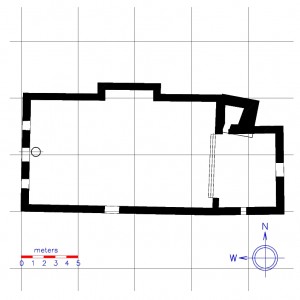
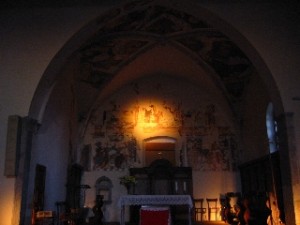
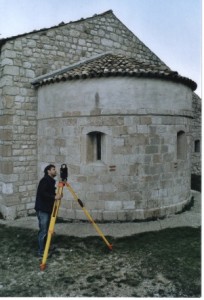
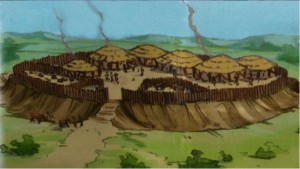
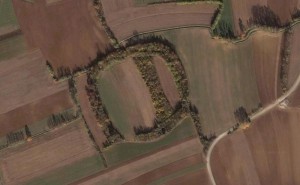
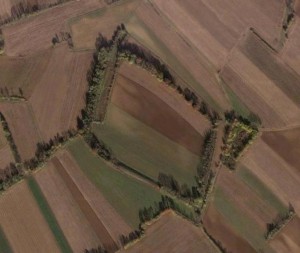

1 Comment
I’m fascinated with your account on these sites,
Looking forward to the next post !!
By the way there are some Archaeoastro sites in Sri Lanka, where I live. I’m sure you might have heard of Star Gate, which is here http://img5.imageshack.us/img5/8499/img0965z.jpg